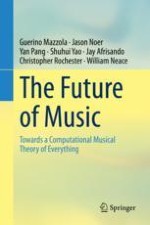2020 | OriginalPaper | Buchkapitel
9. Big Science in Music
verfasst von : Guerino Mazzola, Jason Noer, Yan Pang, Shuhui Yao, Jay Afrisando, Christopher Rochester, William Neace
Erschienen in: The Future of Music
Aktivieren Sie unsere intelligente Suche, um passende Fachinhalte oder Patente zu finden.
Wählen Sie Textabschnitte aus um mit Künstlicher Intelligenz passenden Patente zu finden. powered by
Markieren Sie Textabschnitte, um KI-gestützt weitere passende Inhalte zu finden. powered by
